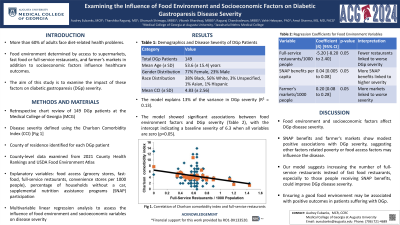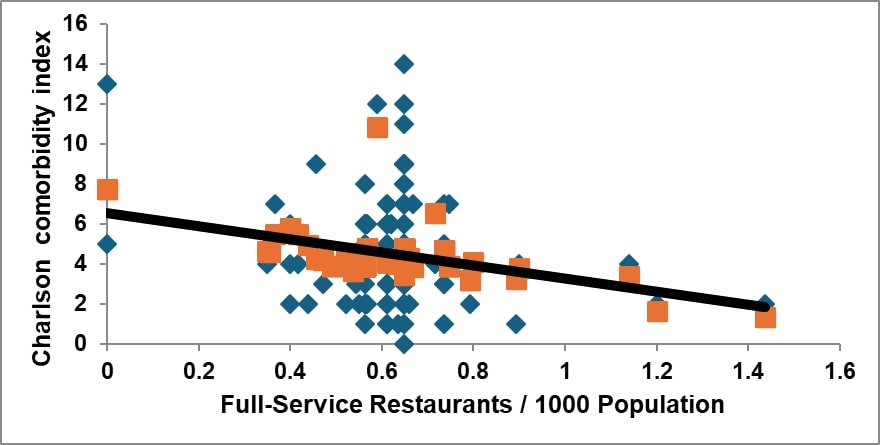Monday Poster Session
Category: Functional Bowel Disease
P2344 - Examining the Influence of Food Environment and Socioeconomic Factors on Diabetic Gastroparesis Disease Severity
Monday, October 28, 2024
10:30 AM - 4:00 PM ET
Location: Exhibit Hall E

Has Audio

Audrey Eubanks, PhD
Augusta University
Evans, GA
Presenting Author(s)
Audrey Eubanks, PhD1, Tharshika Raguraj, MD1, Dhanush Shimoga, MBBS2, Vikarsh Bhardwaj, MBBS3, Raguraj Chandradevan, MBBS2, Vahѐ Heboyan, PhD1, Amol Sharma, MS, MD, FACG2
1Augusta University, Augusta, GA; 2Medical College of Georgia at Augusta University, Augusta, GA; 3Jawaharlal Nehru Medical College, New Dehli, Delhi, India
Introduction: More than 60% of adults face diet-related health problems. Research suggests the food environment determined by access to supermarkets, fast food or full-service restaurants, and farmer’s markets in addition to socioeconomic factors influence healthcare outcomes. The objective of this study is to examine the impact of these factors on diabetic gastroparesis (DGp) severity.
Methods: A retrospective chart review of 149 DGp patients seen and managed at Medical College of Georgia (MCG) was performed. Disease severity was defined using the Charlson Comorbidity Index (CCI). County of residence for each DGp patient was identified. County-level data of DGp patients were examined from publicly available data sets (2021 County Health Rankings and USDA Food Environment Atlas). Explanatory variables included food access (number of grocery stores, fast-food restaurants, full-service restaurants, and convenience stores per 1000 people), percentage of households with no car, and percentage of county population participating in supplemental nutrition assistance programs (SNAP). Multivariable linear regression analysis was performed to estimate the influence of food environment and socioeconomic variables on disease severity.
Results: Demographics of the 149 DGp patients were similar to those of the Central Savannah River Area (CSRA) (38% Black, 56% White, 3% Unspecified, 1% Asian, 1% Hispanic) and gastroparesis overall (77% female, 23% male; Mean age ± SD of 53.6 ± 15.4 years). Mean CCI for DGp subjects was 4.83 ± 2.56. A model of multivariable linear regression between food environment variables and DGp disease severity with R2 of 0.13. Coefficients of the model for full-service restaurants / 1000 people (ß = -5.2, 95% CI -8.2 to 2.4), SNAP benefits per capita (ß = 0.04, 95% CI 0.005 to 0.08), farmer’s markets / 1000 people (ß = 0.2, 95% CI 0.08 to 0.28), and intercept (6.3, 95% CI 4.4 to 8.2) were all significant (p=0.05).
Discussion: Food environment and socioeconomic factors affect DGp disease severity. Our model suggests increasing the number of full-service restaurants, especially to those people receiving SNAP benefits, could improve DGp disease severity. Ensuring a good food environment may be associated with positive outcomes in patients suffering with DGp.

Disclosures:
Audrey Eubanks, PhD1, Tharshika Raguraj, MD1, Dhanush Shimoga, MBBS2, Vikarsh Bhardwaj, MBBS3, Raguraj Chandradevan, MBBS2, Vahѐ Heboyan, PhD1, Amol Sharma, MS, MD, FACG2. P2344 - Examining the Influence of Food Environment and Socioeconomic Factors on Diabetic Gastroparesis Disease Severity, ACG 2024 Annual Scientific Meeting Abstracts. Philadelphia, PA: American College of Gastroenterology.
1Augusta University, Augusta, GA; 2Medical College of Georgia at Augusta University, Augusta, GA; 3Jawaharlal Nehru Medical College, New Dehli, Delhi, India
Introduction: More than 60% of adults face diet-related health problems. Research suggests the food environment determined by access to supermarkets, fast food or full-service restaurants, and farmer’s markets in addition to socioeconomic factors influence healthcare outcomes. The objective of this study is to examine the impact of these factors on diabetic gastroparesis (DGp) severity.
Methods: A retrospective chart review of 149 DGp patients seen and managed at Medical College of Georgia (MCG) was performed. Disease severity was defined using the Charlson Comorbidity Index (CCI). County of residence for each DGp patient was identified. County-level data of DGp patients were examined from publicly available data sets (2021 County Health Rankings and USDA Food Environment Atlas). Explanatory variables included food access (number of grocery stores, fast-food restaurants, full-service restaurants, and convenience stores per 1000 people), percentage of households with no car, and percentage of county population participating in supplemental nutrition assistance programs (SNAP). Multivariable linear regression analysis was performed to estimate the influence of food environment and socioeconomic variables on disease severity.
Results: Demographics of the 149 DGp patients were similar to those of the Central Savannah River Area (CSRA) (38% Black, 56% White, 3% Unspecified, 1% Asian, 1% Hispanic) and gastroparesis overall (77% female, 23% male; Mean age ± SD of 53.6 ± 15.4 years). Mean CCI for DGp subjects was 4.83 ± 2.56. A model of multivariable linear regression between food environment variables and DGp disease severity with R2 of 0.13. Coefficients of the model for full-service restaurants / 1000 people (ß = -5.2, 95% CI -8.2 to 2.4), SNAP benefits per capita (ß = 0.04, 95% CI 0.005 to 0.08), farmer’s markets / 1000 people (ß = 0.2, 95% CI 0.08 to 0.28), and intercept (6.3, 95% CI 4.4 to 8.2) were all significant (p=0.05).
Discussion: Food environment and socioeconomic factors affect DGp disease severity. Our model suggests increasing the number of full-service restaurants, especially to those people receiving SNAP benefits, could improve DGp disease severity. Ensuring a good food environment may be associated with positive outcomes in patients suffering with DGp.

Figure: Correlation of charlson comorbidity index and full service restaurants
Disclosures:
Audrey Eubanks indicated no relevant financial relationships.
Tharshika Raguraj indicated no relevant financial relationships.
Dhanush Shimoga indicated no relevant financial relationships.
Vikarsh Bhardwaj indicated no relevant financial relationships.
Raguraj Chandradevan indicated no relevant financial relationships.
Vahѐ Heboyan indicated no relevant financial relationships.
Amol Sharma indicated no relevant financial relationships.
Audrey Eubanks, PhD1, Tharshika Raguraj, MD1, Dhanush Shimoga, MBBS2, Vikarsh Bhardwaj, MBBS3, Raguraj Chandradevan, MBBS2, Vahѐ Heboyan, PhD1, Amol Sharma, MS, MD, FACG2. P2344 - Examining the Influence of Food Environment and Socioeconomic Factors on Diabetic Gastroparesis Disease Severity, ACG 2024 Annual Scientific Meeting Abstracts. Philadelphia, PA: American College of Gastroenterology.
